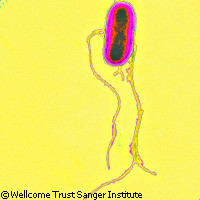Unlocking DNA to tackle typhoid fever
In a world first, the latest in next-generation DNA sequencing technologies has been applied to typhoid fever. These efforts will not only help to improve diagnosis, but also track the spread of disease and offer scientists insights into ways in which the disease could be fought. Typhoid is a particularly nasty disease and despite science's best efforts, is still a blight on the world. Over 600 000 people succumb to typhoid fever each year and according to conservative estimates by the World Health Organization there are 17 million cases of the disease each year. Typhoid is transmitted through the ingestion of food or water contaminated with feces from an infected person. The illness is caused by the bacterium salmonella enterica serovar Typhi. While typhoid is related to the genus salmonella, it is different from many other types of bacteria because it is only found in humans. What this study is doing, is setting a new standard for analysing the evolution and spread of a disease-causing bacterium. Indeed it is the first ever study of multiple samples of any bacterial pathogen at this level of detail. Already they have uncovered previously hidden genetic signatures of the evolution of individual lineages of Salmonella Typhi. 'Modern genomic methods can be used to develop answers to diseases that have plagued humans for many years,' explains Professor Gordon Dougan from the Wellcome Trust Sanger Institute and senior author on the study. 'Genomes are a legacy of an organism's existence, indicating the paths it has taken and the route it is on. This analysis suggests we may have found Typhi's Achilles' heel: in adapting to an exclusively human lifestyle, it has become complacent, its genome is undergoing genetic decay and it's heading up an evolutionary dead end in humans.' What the team has discovered is that the Typhi genome decays as it becomes more closely allied to its human host. In other words, Typhi rids itself of any and all genes that are superfluous to life in the human body. This is not all, early evidence is also suggesting that Typhi has a strategy to protect itself from the immune system of the body. 'Both the genome and the proteins that make up the surface of Typhi - the target areas for vaccines - show amazingly little variation,' said Professor Julian Parkhill, Head of Pathogen Genomics. 'We have been able to use novel technologies, developed for the analysis of human genome variation, to identify this variation. This would have been impossible a year ago. The technologies we have developed here could also be used in the battles against other disease-causing bacteria.' The international team, made up of researchers from the EU and Vietnam, has developed methods that can be used to identify outbreaks. 'Using the genomic biology of this study, we can now type Typhi, identify the strain that is causing infection, identify carriers and direct vaccination programmes most efficiently. It is a remarkable step forward,' said Kathryn Holt, a PhD student at the Wellcome Trust Sanger Institute. This will allow future researchers to identify individual organisms that are spreading in the population. Furthermore, the team hopes that mapping data could then be employed in conjunction with their research to better target vaccination campaigns with the aim of eradicating typhoid fever. 'We believe that concerted vaccination programmes, combined with epidemiological studies aiming to track down and treat carriers, could be used to eradicate typhoid as a disease,' said Professor Dougan.



